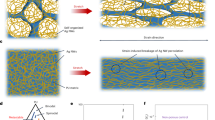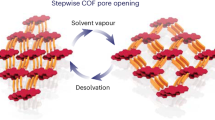Abstract
Exploiting the properties of two-dimensional crystals requires a mass production method able to produce heterostructures of arbitrary complexity on any substrate. Solution processing of graphene allows simple and low-cost techniques such as inkjet printing to be used for device fabrication. However, the available printable formulations are still far from ideal as they are either based on toxic solvents, have low concentration, or require time-consuming and expensive processing. In addition, none is suitable for thin-film heterostructure fabrication due to the re-mixing of different two-dimensional crystals leading to uncontrolled interfaces and poor device performance. Here, we show a general approach to achieve inkjet-printable, water-based, two-dimensional crystal formulations, which also provide optimal film formation for multi-stack fabrication. We show examples of all-inkjet-printed heterostructures, such as large-area arrays of photosensors on plastic and paper and programmable logic memory devices. Finally, in vitro dose-escalation cytotoxicity assays confirm the biocompatibility of the inks, extending their possible use to biomedical applications.
This is a preview of subscription content, access via your institution
Access options
Access Nature and 54 other Nature Portfolio journals
Get Nature+, our best-value online-access subscription
$29.99 / 30 days
cancel any time
Subscribe to this journal
Receive 12 print issues and online access
$259.00 per year
only $21.58 per issue
Buy this article
- Purchase on Springer Link
- Instant access to full article PDF
Prices may be subject to local taxes which are calculated during checkout





Similar content being viewed by others
References
Salaneck, W. R., Lundstrom, I., Huang, W. S. & Macdiarmid, A. G. A 2-dimensional surface-state diagram for polyaniline. Synthet. Met. 13, 291–297 (1986).
Sirringhaus, H. et al. High-resolution inkjet printing of all-polymer transistor circuits. Science 290, 2123–2126 (2000).
Baeg, K.-J., Caironi, M. & Noh, Y.-Y. Toward printed integrated circuits based on unipolar or ambipolar polymer semiconductors. Adv. Mater. 25, 4210–4244 (2013).
Hutchings, I. M. & Martin, G. D. Inkjet Technology for Digital Fabrication Ch. 4 (Wiley, 2012).
Novoselov, K. S. et al. Two-dimensional atomic crystals. Proc. Natl Acad. Sci. USA 102, 10451–10453 (2005).
Novoselov, K. S. et al. A roadmap for graphene. Nature 490, 192–200 (2012).
Geim, A. K. Graphene: status and prospects. Science 324, 1530–1534 (2009).
Geim, A. K. & Novoselov, K. S. The rise of graphene. Nat. Mater. 6, 183–191 (2007).
Akinwande, D., Petrone, N. & Hone, J. Two-dimensional flexible nanoelectronics. Nat. Commun. 5, 5678 (2014).
Geim, A. K. & Grigorieva, I. V. Van der Waals heterostructures. Nature 499, 419–425 (2013).
Withers, F. et al. Light-emitting diodes by band-structure engineering in van der Waals heterostructures. Nat. Mater. 14, 301–306 (2015).
Withers, F. et al. Heterostructures produced from nanosheet-based inks. Nano Lett. 14, 3987–3992 (2014).
Kelly, A. G., Finn, D., Harvey, A., Hallam, T. & Coleman, J. N. All-printed capacitors from graphene-BN-graphene nanosheet heterostructures. Appl. Phys. Lett. 109, 023107 (2016).
Hernandez, Y. et al. High-yield production of graphene by liquid-phase exfoliation of graphite. Nat. Nanotech. 3, 563–568 (2008).
Coleman, J. N. et al. Two-dimensional nanosheets produced by liquid exfoliation of layered materials. Science 331, 568–571 (2011).
Finn, D. J. et al. Inkjet deposition of liquid-exfoliated graphene and MoS2 nanosheets for printed device applications. J. Mater. Chem. C 2, 925–932 (2014).
Torrisi, F. et al. Inkjet-printed graphene electronics. ACS Nano 6, 2992–3006 (2012).
Li, J. et al. Efficient inkjet printing of graphene. Adv. Mater. 25, 3985–3992 (2013).
Secor, E. B., Prabhumirashi, P. L., Puntambekar, K., Geier, M. L. & Hersam, M. C. Inkjet printing of high conductivity, flexible graphene patterns. J. Phys. Chem. Lett. 4, 1347–1351 (2013).
Yao, Y. et al. High-concentration aqueous dispersions of MoS2 . Adv. Funct. Mater. 23, 3577–3583 (2013).
Li, J., Naiini, M. M., Vaziri, S., Lemme, M. C. & Östling, M. Inkjet printing of MoS2 . Adv. Funct. Mater. 24, 6524–6531 (2014).
Zheng, J. et al. High yield exfoliation of two-dimensional chalcogenides using sodium naphthalenide. Nat. Commun. 5, 2995 (2014).
Gorter, H. et al. Toward inkjet printing of small molecule organic light emitting diodes. Thin Solid Films 532, 11–15 (2013).
Gaikwad, A. M. et al. Identifying orthogonal solvents for solution processed organic transistors. Org. Electron. 30, 18–29 (2016).
Lotya, M. et al. Liquid phase production of graphene by exfoliation of graphite in surfactant/water solutions. J. Am. Chem. Soc. 131, 3611–3620 (2009).
Lotya, M., King, P. J., Khan, U., De, S. & Coleman, J. N. High-concentration, surfactant-stabilized graphene dispersions. ACS Nano 4, 3155–3162 (2010).
Yang, H. et al. A simple method for graphene production based on exfoliation of graphite in water using 1-pyrenesulfonic acid sodium salt. Carbon 53, 357–365 (2013).
Yang, H. et al. Dielectric nanosheets made by liquid-phase exfoliation in water and their use in graphene-based electronics. 2D Mater. 1, 1–10 (2014).
Schlierf, A. et al. Nanoscale insight into the exfoliation mechanism of graphene with organic dyes: effect of charge, dipole and molecular structure. Nanoscale 5, 4205–4216 (2013).
Parviz, D. et al. Dispersions of non-covalently functionalized graphene with minimal stabilizer. ACS Nano 6, 8857–8867 (2012).
Reis, N. & Derby, B. Ink jet deposition of ceramic suspensions: modeling and experiments of droplet formation. MRS Online Proceeding Library Archive 625, 117–122 (2000).
Hu, H. & Larson, R. G. Marangoni effect reverses coffee-ring depositions. J. Phys. Chem. B 110, 7090–7094 (2006).
Shin, P., Sung, J. & Lee, M. H. Control of droplet formation for low viscosity fluid by double waveforms applied to a piezoelectric inkjet nozzle. Microelectron. Reliab. 51, 797–804 (2011).
Stauffer, D. & Aharony, A. Introduction To Percolation Theory Ch. 5 (Taylor & Francis, 1994).
De, S. & Coleman, J. N. Are there fundamental limitations on the sheet resistance and transmittance of thin graphene films? ACS Nano 4, 2713–2720 (2010).
Secor, E. B. & Hersam, M. C. Emerging carbon and post-carbon nanomaterial inks for printed electronics. J. Phys. Chem. Lett. 6, 620–626 (2015).
Eastwood, M. A., Brydon, W. G. & Anderson, D. M. The dietary effects of xanthan gum in man. Food Addit. Contam. 4, 17–26 (1987).
Wheeler, J. S. R. et al. Effect of polymer branching on degradation during inkjet printing. Polym. Degrad. Stab. 128, 1–7 (2016).
Kostarelos, K. & Novoselov, K. S. Graphene devices for life. Nat. Nanotech. 9, 744–745 (2014).
Ali-Boucetta, H., Al-Jamal, K. T. & Kostarelos, K. Cytotoxic assessment of carbon nanotube interaction with cell cultures. Methods Mol. Biol. 726, 299–312 (2011).
Latiff, N. et al. Toxicity of layered semiconductor chalcogenides: beware of interferences. RSC Adv. 5, 67485–67492 (2015).
Shah, P., Narayanan, T. N., Li, C. Z. & Alwarappan, S. Probing the biocompatibility of MoS2 nanosheets by cytotoxicity assay and electrical impedance spectroscopy. Nanotechnology 26, 1–7 (2015).
Wang, X. et al. Differences in the toxicological potential of 2D versus aggregated molybdenum disulfide in the lung. Small 11, 5079–5087 (2015).
Teo, W. Z., Chng, E. L., Sofer, Z. & Pumera, M. Cytotoxicity of exfoliated transition-metal dichalcogenides (MoS2, WS2, and WSe2) is lower than that of graphene and its analogues. Chem. Eur. J. 20, 9627–9632 (2014).
Chng, E. L., Sofer, Z. & Pumera, M. MoS2 exhibits stronger toxicity with increased exfoliation. Nanoscale 6, 14412–14418 (2014).
Yong, Y. et al. WS2 nanosheet as a new photosensitizer carrier for combined photodynamic and photothermal therapy of cancer cells. Nanoscale 6, 10394–10403 (2014).
Cheng, L. et al. PEGylated WS2 nanosheets as a multifunctional theranostic agent for in vivo dual-modal CT/photoacoustic imaging guided photothermal therapy. Adv. Mater. 26, 1886–1893 (2014).
Acknowledgements
This work was partially supported by the Grand Challenge EPSRC grant EP/N010345/1 and the European Science Foundation (ESF) under the EUROCORES Programme EuroGRAPHENE (GOSPEL). F.W. acknowledges support from the Royal Academy of Engineering. D.M.M. acknowledges the EPSRC in the framework of the NoWNano CDT. S.S. acknowledges support by the Army Research Office. S.V. acknowledges the ‘RADDEL’ project (Marie Curie Initial Training Network (ITN) grant no. 290023) under the EU's FP7 PEOPLE programme. K.K., G.I. and G.F. acknowledge financial support from EU FP7-ICT-2013-FET-F Graphene Flagship project (no. 604391) and the Project ‘Graphene Flagship’ Core 1 (contract no. 696656). C.C. and D.M.M. thank K. S. Novoselov, J. Wheeler and A. Valentine Parry for discussions.
Author information
Authors and Affiliations
Contributions
C.C. conceived and designed the experiments. D.M.M. developed the inks, with initial assistance from V.S.-R., and conducted all experiments. H.Y. and R.S. performed preliminary experiments. K.P. contributed to the electrical measurements data. S.-K.S. contributed to the transfer of CVD graphene. Device characterization was performed by F.W. and D.M.M. G.F. and G.I. conceived the logic memory device with assistance from C.C. The device was fabricated by D.M.M. and measured by M.M. All biological studies were conceived, designed and performed by S.V. and K.K. The manuscript was written by C.C., D.M.M., G.F., S.V. and K.K., in close consultation with all authors.
Corresponding author
Ethics declarations
Competing interests
The authors declare no competing financial interests.
Supplementary information
Supplementary information
Supplementary information (PDF 1381 kb)
Supplementary Movie 1
Supplementary Movie 1 (AVI 162 kb)
Supplementary Movie 2
Supplementary Movie 2 (AVI 431 kb)
Rights and permissions
About this article
Cite this article
McManus, D., Vranic, S., Withers, F. et al. Water-based and biocompatible 2D crystal inks for all-inkjet-printed heterostructures. Nature Nanotech 12, 343–350 (2017). https://doi.org/10.1038/nnano.2016.281
Received:
Accepted:
Published:
Issue Date:
DOI: https://doi.org/10.1038/nnano.2016.281
This article is cited by
-
Heavy-to-light electron transition enabling real-time spectra detection of charged particles by a biocompatible semiconductor
Nature Communications (2024)
-
Advance in additive manufacturing of 2D materials at the atomic and close-to-atomic scale
npj 2D Materials and Applications (2024)
-
Scalable graphene sensor array for real-time toxins monitoring in flowing water
Nature Communications (2023)
-
Electrochemical molecular intercalation and exfoliation of solution-processable two-dimensional crystals
Nature Protocols (2023)
-
Printed transistors made of 2D material-based inks
Nature Reviews Materials (2023)



